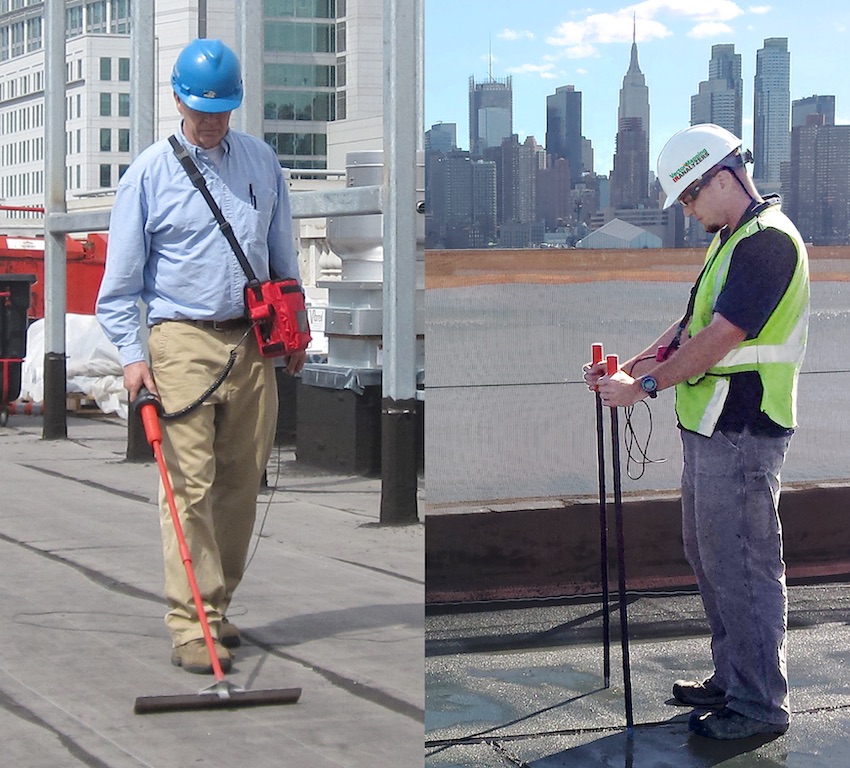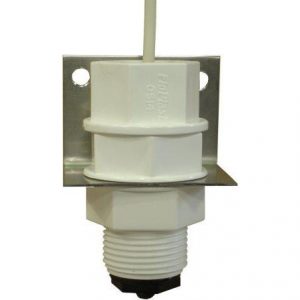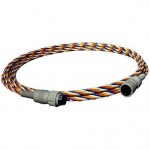HOW TO SELECT THE CORRECT TYPE OF WATER LEAK DETECTION SENSOR FOR YOUR APPLICATION
Air Conditioning Drip Trays
Two sensors are available, the optical DTS sensor designed to sit in a drip tray, IP65 rated with no external electrical electrodes, and our leak detection cable type WDC4, this being very flexible, it can can be shaped around the tray for maximum coverage
Drip Trays underneath Water or Chilled Water Pipework
For long runs of drip trays our water detection cable type WDC4 is best suited as it can be serpentine in the tray to give maximum coverage.
Water or Chilled water Pipes with no Drip Tray
Our WDC4 detection cable can be fixed to the underside of the pipework along its entire length so any leak will be detected. Whilst care should be taken not to over tighten, cable ties can be used around the pipe at approximately 1 to 1.5 metre intervals.
Service pits, Sump or Drain Pits
The best sensor for this application is our Optical spot probe. With no exposed electrical electrodes, this sensor is not susceptible to impact damage to the sensing part of it. Being IP65 rated, the sensor can be screwed to the inside of pit and fully submerged in water.
Room perimeter monitoring and underfloor areas.
Two sensors are available, our standard WDC4 detection cable that will report a leak found anywhere along its length, and our DMWD cable, that when used with the DMWD alarm unit gives a measurement in metres from the controller to the leak. Both types of cable should be Clipped to the floor every 1 to 1.5 metres.

Electronic Leak Detection—Four Steps to Maximize Results
Electronic Leak Detection (ELD) has become the gold standard for both integrity testing of newly installed membranes and forensic leak detection on older assemblies. While thousands of ELD tests have been successfully and accurately performed, not all tests will provide thorough and accurate information. In this webinar, we will explore the differences between different types of ELD and learn how to select the best test type for your particular situation. We will cover the proactive steps you should take to ensure the most accurate test, and discuss techniques for managing your customers’ expectations when assemblies are challenging or impossible to accurately survey. This course will be of great benefit to anyone who works in design, specification, consulting, construction, or purchase of roofing and waterproofing membranes.
Learning Objectives:
Identify the advantages and disadvantages of the three different types of Electronic Leak Detection (ELD) and describe how to choose the most effective survey technique(s) for your particular application.
Ensure optimal ELD survey results by incorporating the best design and construction practices before your ELD survey team arrives.
Vet and select an ELD service provider that will conduct a thorough and accurate test that meets the demands of the construction schedule and all project stakeholders.
Discuss why it is not possible to find every leak, and why some assemblies are challenging or impossible to test.

The Best Smart Water-Leak Detector
Splashing the day away sounds like fun—unless the splashing is happening in your basement or kitchen, or there’s a puddle seeping from the toilet. A smart water-leak sensor can lessen the impact of plumbing problems by alerting you the moment they’re detected, whether you’re at home or away. We recommend the Flo by Moen Smart Water Detector because it’s the only device we tested that responded quickly to both water and connectivity issues. It’s wire-free, making it easy to place, and it includes temperature sensors, so you can detect when pipes are beginning to freeze, before they burst.
The Flo by Moen Smart Water Detector responded consistently both to leaks and to connectivity or power issues, and it did so faster than most of the devices we tested. It’s also cordless, so it’s easy to place without having to worry about an electrical outlet. The Flo’s main unit is droplet-shaped and has sensing probes on the bottom of the device; you can also attach a 4-foot extender probe, so you can sneak it into tight spaces. We like that the Flo also measures temperature and humidity and has an onboard audible alarm (although it isn’t very loud). Unfortunately, it doesn’t integrate with other popular smart-home platforms, like Alexa, HomeKit, and Google Assistant, but it does work with Flo’s water shutoff system—a smart water valve that can turn off your home’s water service if it detects a potentially catastrophic leak
The D-Link DCH-S161 is a great choice because its loud, 80-decibel (dB) alarm pierces long distances in a home. It also has support for Google Assistant and IFTTT (If This Then That), which allows you to link the sensor to other smart devices, so you can ensure that alerts are noticed. The D-Link is one of the few devices we tested that allows you to silence alarms directly on the device as well as in the app, which is useful. An included 6-foot sensor cable is longer than the one used by the Flo, but we found it doesn’t react as quickly to water and connectivity issues, and it doesn’t have a built-in temperature sensor.
The Proteus Aquo Wi-Fi Water Sensor is more customizable than any other standalone device we reviewed. You can program alarm times, schedule power notifications, and integrate it with Amazon Alexa and IFTTT. This device also has the loudest audible alarm (85 dB) of any system we tested, and it is the only one that can integrate up to five sensors simultaneously (including one for a sump pump). But that customization can be complicated, there’s no dedicated smartphone app (you use a Web browser to administer it), the device needs to be plugged into the wall, and it’s twice the price of our top pick.

Expert Tips for Choosing a Leak Detection System
While cooped up at home during the coronavirus pandemic, one of the last things a homeowner would want is a leak in the pipes. Besides being a hassle, major water damage can be crushingly expensive: the average insurance claim is $10,234. If homeowners invest in a leak detection system, however, they can use the system to monitor the home’s pipes. The unit identifies leaks and alerts homeowners to the situation before it gets worse. From $100 units to systems that cost over $1500, choosing the right model for a home can be a daunting task, but one plumber shares his tips for finding a system perfect for your next project.
Water damage ranks as the third leading cause of homeowner loss, according to the Insurance Information Institute, and the third most expensive, with an average $10,234 claim, based on the trade group’s latest figures.
If you’ve had water damage in your home, or in a rental property you own, you know how disruptive and stressful the clean-up and restoration process can be. If there were a way to detect a potential problem source before it caused damage, would you try it? Would your insurer provide a discount for doing so?
The answer to the first question is probably yes. If a small cost lets you identify leaking pipes or hoses and running faucets before they create a flood, there’d be little reason not to do so. A leak detection system can help you do this. Basic models without shut-off capability start at less than $100. Professional grade systems can cost $1500 or more, which is still lower than some single year deductibles. There are many systems in the middle of the price range, depending on the capabilities you want and need.
An Ounce Of Prevention
If you’ve had water damage in your home, or in a rental property you own, you know how disruptive and stressful the clean-up and restoration process can be. If there were a way to detect a potential problem source before it caused damage, would you try it? Would your insurer provide a discount for doing so?
The answer to the first question is probably yes. If a small cost lets you identify leaking pipes or hoses and running faucets before they create a flood, there’d be little reason not to do so. A leak detection system can help you do this. Basic models without shut-off capability start at less than $100. Professional grade systems can cost $1500 or more, which is still lower than some single year deductibles. There are many systems in the middle of the price range, depending on the capabilities you want and need.
How To Choose A Leading Water Leak Detection Company
Does your building have perennial water leaks that never seem to go away? It could even be a recent water leak that needs to be fixed as a matter of urgency. Water leak detection companies offer professional services to help detect and fix all manner of leaks. There are numerous such companies and finding the right one can be somewhat tricky. What factors should you consider when choosing a water leak detection company?
Reliability; one of the most crucial factors to look out for is reliability. It would be pointless dealing with a very qualified and professional leak detection company that doesn’t keep time. Reliability means the ability to respond to your emergencies right away without delays or excuses.
Skills; water leak detection is a complex task that requires more than your ordinary plumber. Modern water leak detection companies rely on the latest technology like thermal imaging cameras and acoustic listening devices. With such, even the most hidden water leaks can be detected. Instead of spending so much money on a plumbing company to fix a perennial water leak, get leak detection companies because they’re best qualified for such.
Accredited; you want to be very sure that your water leak is handled by a qualified and competent professional. This gives you the assurance that the job will be done well, and that safety standards will be observed. They’re a fully licensed, certified, and licensed company. Their engineers are competent and thoroughly experienced in handling all types of water leaks. They observe the highest safety standards at all times.
Experience; some water leaks in your building will need more than just the latest technology and skills. Experience has its place too. Get a water leak detection company that has the necessary experience. Hidden water leaks, in particular, can be hard to pinpoint. You may remove tiles or chip off a wall only to find that the source of the leak isn’t even located there! To avoid such trial and error methods, get an experienced engineer to handle that.